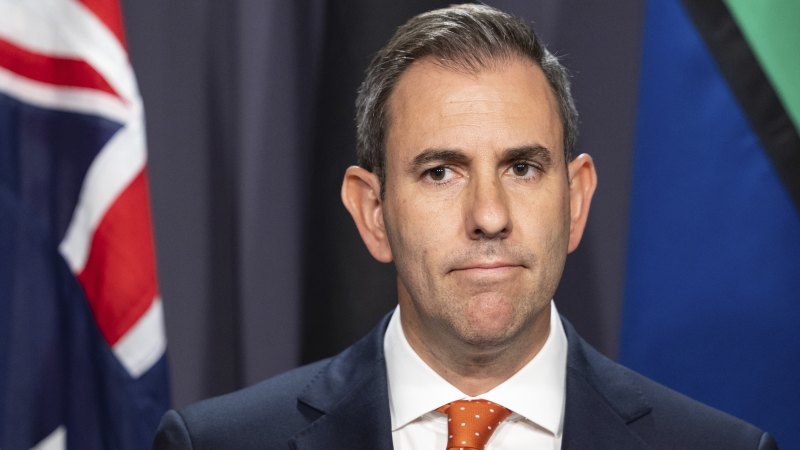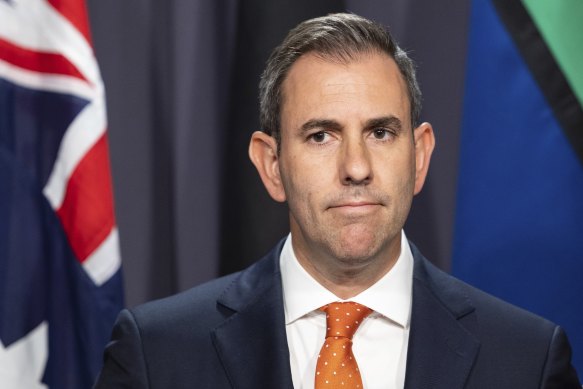Save articles for later
Add articles to your saved list and come back to them any time.
A plan to overhaul the nation’s migration program is expected to reduce the number of low-paid immigrants entering the country by up to 31,000 a year, with the federal budget to reveal a much smaller Australia.
A planned increase in the minimum wage threshold for temporary skilled migrants, from $53,900 to $70,000 from July 1, will lead to fewer migrants and ultimately contribute to a shortfall of 620,000 in Australia’s forecast population.
Treasurer Jim Chalmers will reveal a smaller Australia in Tuesday’s budget.Credit: Alex Ellinghausen
Tuesday’s budget, to be handed down by Treasurer Jim Chalmers, will also predict the current spike in net overseas migration will quickly fall back to its long-term trend.
Home Affairs Minister Clare O’Neil last week released the government’s long-awaited migration review, which found the current system was not fit for purpose and could easily be used to exploit potential workers.
O’Neil revealed the minimum payment for skilled migrants, which had been frozen at $53,900 for a decade, would be pushed up to ensure the scheme was a “skilled worker program, not a guest worker program”.
The impact of the change will be immediately felt, with a sharp drop in the number of expected working migrants and their spouses.
Chalmers on Tuesday will confirm net overseas migration – which covers the movement of all but short-term tourists in and out of Australia – will hit an all-time high of 400,000 this financial year and 315,000 in 2023-24.
This is due to a surge in the number of international students, many of whom were shut out of the country during the COVID-19 border closures, and backpackers returning to Australia. There has also been a fall in the number of people leaving the country, including many international students who would ordinarily have completed their studies and returned to their home country.
The surge is expected to be short-lived, with net migration forecast to fall to 260,000 in 2024-25 and the following year before stepping down further to its long-term trend of 235,000.
Ahead of the pandemic, the Morrison government was forecasting Australia’s population would reach 27 million in early 2023. Instead, Chalmers will reveal population will be closer to 26.4 million.
The shortfall of 620,000 this year will grow to more than 750,000 – or the population of Newcastle and Geelong combined – by the end of the decade.
The shortfall is not expected to be ever made up due, in part, to the continuing decline in Australia’s fertility rate and more moderate levels of net migration.
Demands for the government to reconsider Australia’s migrant intake have grown in recent months, with claims immigration is contributing to the pressure in the property market. Asking rents, as tracked by CoreLogic, climbed by 0.8 per cent in April to be up a record 11.7 per cent over the past year.
Research by the Australian Bureau of Statistics and the Reserve Bank, however, suggests the demand for rental properties is playing out in the outer suburbs of capital cities, and not in CBDs or around university accommodation, which are home to most international students.
The research found 62 per cent of rental properties within 12.5 kilometres of Melbourne’s CBD had rents in February this year lower than in March 2020. In Sydney, 49 per cent of rental properties close to the city centre had lower rents.
But 25 kilometres or beyond the CBD, there were no properties where rents were lower.
The head of economic analysis at the Reserve Bank, Marion Kohler, said the surge in population was being driven by students and working holidaymakers, and would have a flow-on effect on the housing market.
“The higher population growth increases demand for housing. Initially, we expect this adjustment to come through higher rents and higher average household size as growth in the population is faster than the dwelling stock. But in the longer run, there is also a boost to dwelling investment,” she said.
On Wednesday, state and territory housing ministers all signed an open letter to the Senate urging the upper house to pass the bill establishing the federal government’s planned $10 billion Housing Australian Future Fund, saying it was a step towards providing more Australians with a home.
The fund is facing opposition from the Coalition, which is worried by the government borrowing money for the program, and the Greens, which want much more investment in social housing.
The states and territories, which have promised $11.3 billion to provide 34,000 new social and affordable homes over five years, said the housing fund was necessary.
“Delays to the passage of this important piece of legislation will put this delivery at risk, delaying Australians’ access to safe and secure housing, delaying much-needed investments,” they said.
Cut through the noise of federal politics with news, views and expert analysis from Jacqueline Maley. Subscribers can sign up to our weekly Inside Politics newsletter here.
Most Viewed in Politics
From our partners
Source: Read Full Article

